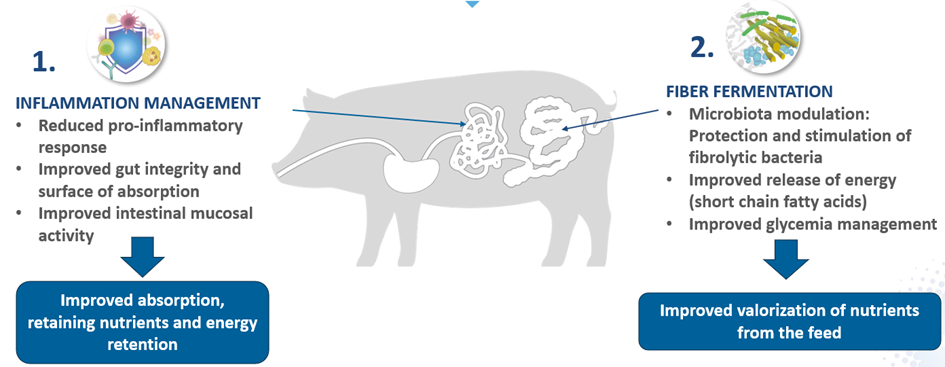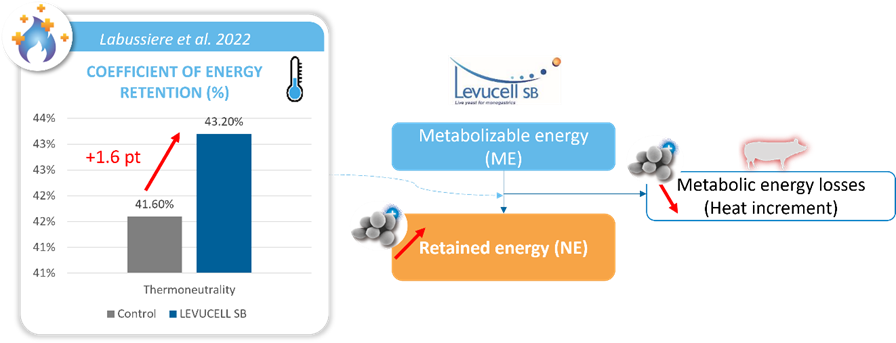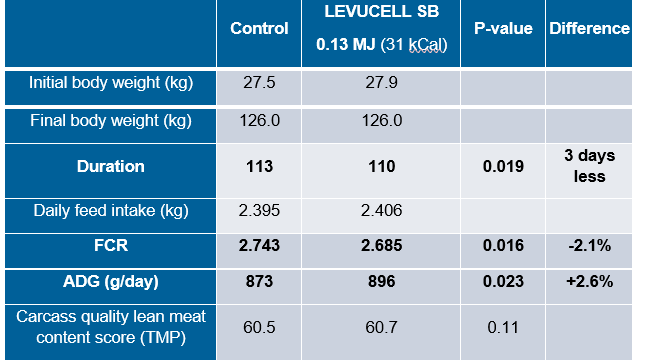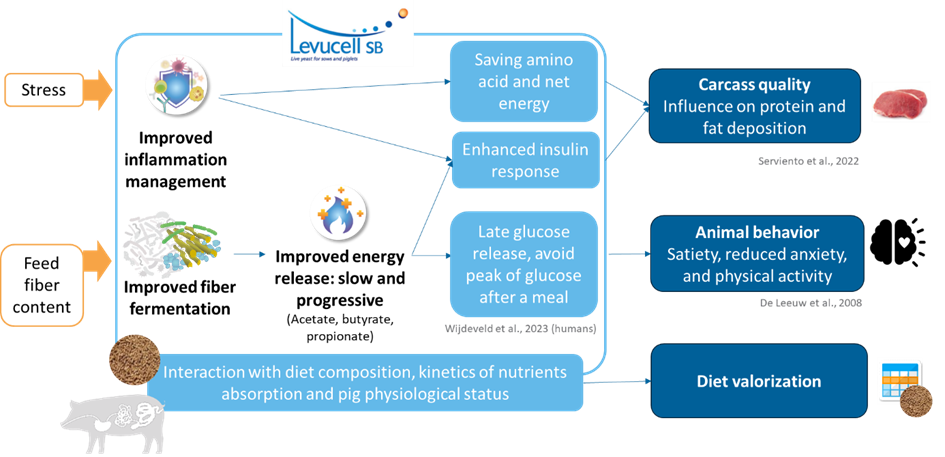Empowering the gut efficiency of fattening pigs to optimize production cost with live yeast
Around 70% of the feed price is determined by the costs of energy supplying feedstuff. Therefore, optimizing pig energy metabolism and its physiological status to extract as much energy as possible from the feed nutrients is a leverage to increase producer profitability. Until now, the use of Saccharomyces cerevisiae boulardii CNCM I-1079 (LEVUCELL SB) has been mainly advocated and documented for its benefits in sow and piglet diet, as both a performance enhancer and gut health promoter. However, precise metabolic studies have long proven that the probiotic yeast can also benefit the nutritional efficiency of fattening pigs. Such studies have enabled us to attribute a minimum energy value to the probiotic (1.6% of total Net Energy of the diet): thus, in the same way as with enzymes, the live yeast effect can be integrated into diet formulation for more accurate nutritional balance and it results in improved production cost.
Dual action at gut level
The live yeast Saccharomyces cerevisiae var. boulardii CNCM I-1079 (LEVUCELL SB) is a probiotic strain with documented benefits for swine performance. Its mode of action is particularly well described. It is proven to act on gut functions at three main levels: stabilization of the intestinal microbiota, improvement of gut integrity, and modulation of the animal’s natural defenses. Taken together these demonstrated effects help explain the benefits on diet valorization in fattening pigs, through two main mechanisms (Figure 1):

Figure 1: The dual effect of live yeast LEVUCELL SB on pig gut that led to improved gut health and maximize the use and transformation of feed nutrients.
On one side, by modulating pig physiology, behavior and metabolism, the live yeast helps save energy diversion towards inflammation for production and growth. In addition, the benefits of the live yeast on gut integrity and morphology (villi development…) help maximize energy and nutrient absorption. The pig uses the maximum energy and nutrient available for growth.
On the other side, the effects of the live yeast on the gut microbiota balance have a positive impact on fiber fermentation. The pig extracts more energy and nutrient from the fibrous part of the diet. This is measured through the protection and stimulation of fibrolytic microbial populations validated in multiple studies at different physiological stages, marked by the deposition of a patent for this specific effect. As a result, we can observe an increased Short Chain Fatty Acids production, an additional source of energy for the gut epithelial cells and for the pigs.
+1.6% retained energy: robust proof in metabolic chambers
The benefits of the probiotic on diet energy valorization have been evaluated in metabolic chambers (Labussière et al., 2022). For this study, finishing pigs were introduced inside metabolic chambers. This procedure allowed the researchers to strictly control the environment of the pigs and to measure their energy expenditure. The trial proved a more efficient use of the metabolizable energy by the pigs when they received the live yeast, vs. control diet. The pigs with the probiotic diet showed an increased Coefficient of Metabolizable Energy Retention (Figure 2).
 Figure 2 – Feed energy retention measured with or without LEVUCELL SB under thermoneutral conditions (Labussiere et al, 2022)
Figure 2 – Feed energy retention measured with or without LEVUCELL SB under thermoneutral conditions (Labussiere et al, 2022)
It was hypothesized that this improved efficiency is linked to the improved gut microbial environment and the lower level of inflammation, saving nutrients for growth instead of the inflammatory process.
In addition, researchers looked at pig metabolism under heat stress conditions (2 weeks under constant ambient temperatures of 28ºC), finding an even greater consequence of the live yeast. Under heat stress, the difference in the coefficient of metabolizable energy retention was much higher (+5.5 % vs. control). Pigs appear more resilient to the challenge when fed the probiotic yeast.
Proven in real commercial conditions
A large scale trial has been recently conducted in France involving 64 batches of pigs (approx. 27,000 pigs) from 17 farms divided between Control and LEVUCELL SB groups. The trial lasted one year in normal commercial conditions. In the LEVUCELL SB group grower and finisher diets were formulated with an energy valorization of 1.3%, equivalent to 0.13 MJ Net energy/kg (31 kCal/kg), and LEVUCELL SB was included at the recommended dosage.
The main outcome is a significant improvement of the feed conversion ratio with a reduction of 0.06 point. The average daily gain has been significantly increased by 2.6%. The final body weight has been reached faster (three days less of fattening period) (Table 1).
In addition, pigs supplemented with LEVUCELL SB tended to have a better lean meat content that could be explained by a better ability of the pigs supplemented with LEVUCELL SB to deposit protein as recently demonstrated in a study of Serviento et al, 2022.
 Table 1 – Zootechnical performance results with or without LEVUCELL SB, Commercial trial, France
Table 1 – Zootechnical performance results with or without LEVUCELL SB, Commercial trial, France
Reduced production cost
In this trial, the improved zootechnical performance and the optimization of the feed formulation when including LEVUCELL SB at 1.3% of energy resulted in a gain of 3€ per pig and a return on investment of 4.7:1.
When considering the feed formulation matrix, the application of an energy valorization when including LEVUCELL SB has an economic impact of 1 to 6€ per ton of feed compared to an on-top application of the product depending on the raw material profile and geographical regions.
One step further: glycemia management
In the study of Serviento et al 2022, it has also been demonstrated that LEVUCELL SB has a positive effect on the insulin sensitivity. Insulin being a key hormone in the glucose metabolism, this study gives more insights on the possible involvement of the live yeast in the glycemia management. The production of Short Chain Fatty Acids by the gut microbiota has a key role on the insulin and glycemic response modulation (Suez et al, 2016).
According to the literature, managing glycemic response together with limiting inflammation could have several beneficial impacts on the pig carcass quality and the animal behavior. (Figure 4)

Figure 4 Hypothesis on the possible involvement of LEVUCELL SB on the carcass quality and animal behavior
The hypothesis that LEVUCELL SB improves glycemia management and protein deposition suggests that its benefits extend beyond gut health. Ongoing research aims to uncover the full potential of LEVUCELL SB in improving pig metabolic functions.
In conclusion, the ability of LEVUCELL SB to empower gut efficiency, optimize diet valorization, and improve resilience against heat stress while contributing to reduced production cost positions it as an interesting tool for the nutrition of fattening pigs. As research continues, the scope of LEVUCELL SB’s impact on pig nutrition is expected to expand, offering new opportunities for sustainable and profitable pig production.
REFERENCES:
Labussière, E., Achard, C., Dubois, S., Combes, S., Castex, M., & Renaudeau, D. (2022). Saccharomyces cerevisiae boulardii CNCM I-1079 supplementation in finishing male pigs helps to cope with heat stress through feeding behaviour and gut microbiota modulation. British Journal of Nutrition, 127(3), 353-368. doi:10.1017/S0007114521001756
Serviento, A., Castex, M., Renaudeau, D., & Labussière, E. (2022). Effect of live yeast supplementation and feeding frequency in male finishing pigs subjected to heat stress. British Journal of Nutrition, 1-37. doi:10.1017/S0007114522002513
Contato:
Entre em contato conosco através do formulário

